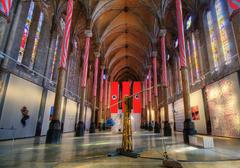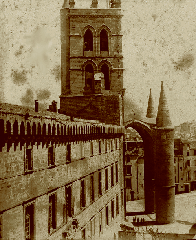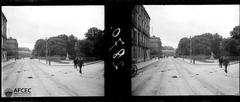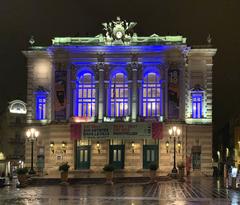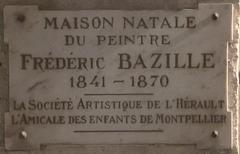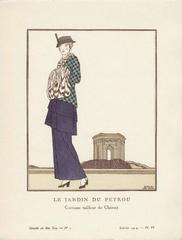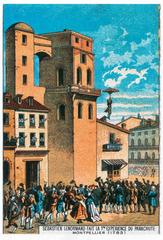
Saint-Mathieu Church Montpellier: Visiting Hours, Tickets, and Historical Sites Guide
Date: 03/07/2025
Introduction
Saint-Mathieu Church, located in the historic Écusson district at the heart of Montpellier, is a remarkable testament to the city’s religious, architectural, and cultural legacy. Merging Gothic artistry, Baroque treasures, and neoclassical interventions, the church offers visitors a window into Montpellier’s complex past—from medieval beginnings and religious upheavals to modern-day community life. As both a place of worship and a cultural venue, Saint-Mathieu Church stands as a living monument, welcoming visitors eager to explore its architecture, history, and significance within the broader context of Montpellier’s heritage.
This guide provides detailed information on Saint-Mathieu Church’s history, architectural highlights, visiting hours, ticketing, accessibility, and nearby attractions, along with practical travel tips to ensure a rewarding visit. For the most current updates, always consult official resources such as the Montpellier city website, the parish website, and local tourism platforms.
Table of Contents
- Historical Overview
- Architectural and Artistic Highlights
- Community and Cultural Role
- Practical Information
- Travel Tips and Recommendations
- Frequently Asked Questions (FAQ)
- References
Historical Overview
Origins and Early Development
Saint-Mathieu Church’s origins trace back to the medieval period, with the first parish church on this site reportedly constructed in the 11th century (patrimoine religieux). The church endured repeated destruction during the Wars of Religion, a turbulent era that saw both the original and subsequent 17th-century buildings razed amid conflict between Catholic and Protestant factions (montpellier3m.fr).
Dominican Influence and Reconstruction
Following the devastation, the Dominicans established a new convent nearby in 1611 and spearheaded the construction of the present church between 1624 and 1627. The Dominicans’ influence shaped not only the religious life of the area but also the architectural design, favoring a sober yet imposing classical style. The church served as the convent chapel and became a center for preaching, education, and charitable works (patrimoine religieux).
Revolutionary Changes and Modern Era
During the French Revolution, Saint-Mathieu was secularized and sold as national property, resulting in the loss and dispersal of some religious artifacts (patrimoine religieux). In 1829, it was restored for public use and the façade was redesigned by architect Joseph Boué in a stark neoclassical style. Bell towers added in the 19th and early 20th centuries gave the church its present silhouette (monumentum.fr). In 2016, the church was listed as a Monument Historique, ensuring its preservation and recognition as a vital part of Montpellier’s heritage.
Architectural and Artistic Highlights
Exterior Features
The church’s façade exemplifies southern French Gothic restraint, with clean lines and minimal ornamentation. The neoclassical redesign by Boué adds a sense of austere grandeur, while the bell towers lend vertical emphasis. Built from locally quarried limestone, the exterior glows with a warm hue in Mediterranean sunlight. Robust buttresses and terracotta-tiled roofs reflect both aesthetic and practical adaptations to the region’s climate (monumentum.fr).
Interior Treasures
Inside, Saint-Mathieu’s nave, side chapels, and ribbed vaults showcase the church’s Gothic roots. Notable interior features include:
- 17th-century Baroque Retables and Altarpieces: Ornately carved and gilded, these reflect the Counter-Reformation’s artistic influence.
- Stained Glass Windows: Illuminating the interior with soft colors, the windows depict biblical figures and scenes, some surviving from the 17th century while others were restored in the 19th century (cathedrale-montpellier.fr).
- Historic Paintings: Restored works, such as Antoine Ranc’s “Saint Jean de la Croix en extase devant la croix,” exemplify the church’s artistic patrimony (herault-tribune.com).
- Liturgical Objects: Includes a historic organ, life-size sculpture of Saint Agnes, and ceremonial items that bear witness to centuries of worship (monumentum.fr).
Community and Cultural Role
Saint-Mathieu Church has long functioned as more than just a place of worship. It served as a parish and convent chapel, a hub for education and charity under the Dominicans, and later as a civic monument and cultural venue. Today, despite not being an active parish church, it continues to host special Masses, concerts, art exhibitions, and events such as European Heritage Days (montpellier3m.fr). Its role in citywide celebrations and outreach programs highlights its ongoing relevance within Montpellier’s diverse and cosmopolitan community.
Practical Information
Visiting Hours
Saint-Mathieu Church is typically open only during special events—notably during the European Heritage Days, select art exhibitions, and significant religious occasions. Regular daily access is not guaranteed. For precise visiting hours and event schedules, consult the official parish website or the Montpellier city website).
- Sample visiting hours during special events: 9:00 AM – 6:00 PM
- Parish office schedule (may vary):
- Tuesday: 7:30 am – 11:30 am, 12:30 pm – 3:30 pm
- Thursday: 10:30 am – 11:30 am, 12:30 pm – 3:30 pm
Tickets and Admission
- General Admission: Free of charge during public openings; donations are appreciated.
- Guided Tours: Occasionally available during special events or by advance arrangement, sometimes with a modest fee (Montpellier tourism portal).
- No tickets required for standard entry; check ahead for ticketed events or exhibitions.
Accessibility
- Wheelchair Access: The main entrance is at street level, but some areas may not be fully accessible due to historic architecture.
- Public Transport: Easily reached via tram Line 1 (Comédie or Louis Blanc stops) and several bus lines. Parking is available at nearby garages; the old town is best navigated on foot or by bike.
- Bicycle Access: Vélomagg’ bike-sharing stations are nearby.
Getting There
- Address: 69 rue de Provence, Montpellier, France
- Tram: Line 1 (Comédie or Louis Blanc stops)
- Parking: Parking Comédie or Parking Corum (short walk required)
- By Foot or Bike: Central location in the historic Écusson makes walking or cycling ideal.
Visitor Services
- Restrooms: Not available inside; use nearby public facilities or local cafés.
- Seating: Benches and pews in the nave.
- Photography: Allowed without flash; be respectful during services or events.
- Dress Code: Modest attire recommended out of respect for the sacred setting.
Nearby Attractions
Combine your visit to Saint-Mathieu Church with other Montpellier historical sites:
- Saint-Pierre Cathedral: Montpellier’s iconic Gothic cathedral.
- Jardin des Plantes: France’s oldest botanical garden, open to the public.
- Place de la Comédie: Central square with cafés and shops.
- Faculty of Medicine: The world’s oldest functioning medical school.
- Basilica Notre-Dame des Tables & Church of Saint-Roch: Other notable churches within walking distance.
Travel Tips and Recommendations
- Check official websites for the latest opening times and event schedules before your visit.
- Visit during special events such as European Heritage Days for the best access.
- Arrive early to enjoy the church in a quieter atmosphere.
- Dress appropriately for a place of worship and maintain a respectful demeanor.
- Plan to explore surrounding landmarks and sample local cafés for a full Montpellier experience.
Frequently Asked Questions (FAQ)
Q: Is Saint-Mathieu Church open daily?
A: No, it is generally only open for special events, Masses, or guided tours. Check official sources for up-to-date hours.
Q: Do I need a ticket to enter?
A: Entry is free; tickets may be required for special exhibitions or tours.
Q: Are guided tours available?
A: Yes, but mainly during special occasions or by arrangement. Advance booking may be necessary.
Q: Is the church accessible for visitors with mobility challenges?
A: Partial street-level access, but some areas may be difficult to navigate.
Q: Can I take photographs?
A: Yes, photography is allowed without flash, except during services.
Q: Where can I find more information?
A: Check the parish website or Montpellier city site.
References
- Patrimoine Religieux: Saint-Mathieu Church
- Montpellier City Website: Les Églises de Montpellier
- Paroisse Cathédrale de Montpellier
- Monumentum: Eglise Saint-Mathieu
- Montpellier3m: Journées Européennes du Patrimoine and Cultural Events
- Montpellier Tourism Portal: Events and Guided Tours
- France This Way: Montpellier Churches and Historical Sites
For interactive maps, virtual tours, and updates on events, download the Audiala app or consult official Montpellier tourism channels. Image suggestions: “Saint-Mathieu Church Montpellier exterior,” “Stained glass interior Saint-Mathieu Church,” and “Historic center near Saint-Mathieu Church.”

